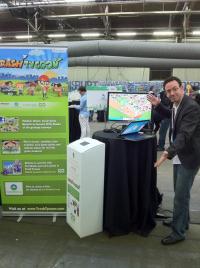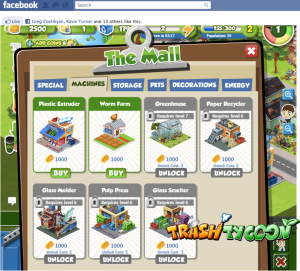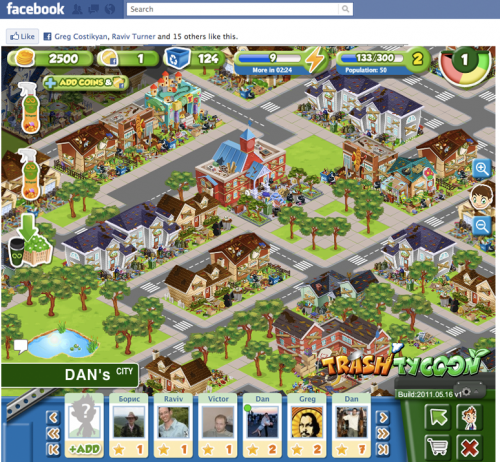Technology for Change: Trash Tycoon
 Singlebrook talks with Raviv Turner, Co-founder and CEO of Guerrillapps, the game developers behind the popular new Facebook game, Trash Tycoon. Through partnerships with big players in the green industry--TerraCycle, Carbonfund.org and Treehugger,Trash Tycoon combines great game mechanics with every day activities like sorting, recycling and upcycling trash. A month after its launch, Trash Tycoon is already seeing real world change through players’ increased involvement with TerraCycle and donations to Carbonfund.org. Trash Tycoon brings a breath of (ironically) fresh air to the world of gamification 1.0 with Turner’s approach: “let the fun drive.”
Singlebrook talks with Raviv Turner, Co-founder and CEO of Guerrillapps, the game developers behind the popular new Facebook game, Trash Tycoon. Through partnerships with big players in the green industry--TerraCycle, Carbonfund.org and Treehugger,Trash Tycoon combines great game mechanics with every day activities like sorting, recycling and upcycling trash. A month after its launch, Trash Tycoon is already seeing real world change through players’ increased involvement with TerraCycle and donations to Carbonfund.org. Trash Tycoon brings a breath of (ironically) fresh air to the world of gamification 1.0 with Turner’s approach: “let the fun drive.”
Singlebrook: Please give a brief overview of what your organization does.
Raviv Turner: There are millions of players on social networks playing social games. Guerillapps takes game mechanics and applies them to burning issues like green, health, energy, water--anything that falls in that segment. We tie into the real world to support real world causes by teaming up with established consumer brands to create fun and engaging games.
Singlebrook: How did you come up with the idea for Trash Tycoon?
RT: As green entrepreneurs, we wanted to do a social game to appeal to the mass of people that play on social networks. We were inspired by the business of TerraCycle which is all about upcycling. So, we started to research upcycling and saw there was a whole new world around trash and what can be done with trash. Great game mechanics can be applied to collecting, sorting, and upcycling trash.
Singlebrook: Can you describe your partnership with TerraCycle on this game?
RT: TerraCycle is a strategic sponsor of Trash Tycoon. They not only market the game to the over 21 million users of TerraCycle, but they also pitch the game to their partners, some of the top consumer packaged goods companies. We have all sorts of cool, deep branding of TerraCycle into the game. Players can collect TerraCycle items, put TerraCyle factories on the map, and make and bottle a TerraCycle product like fertilizer. The most important aspect of the collaboration is that players sign up with TerraCycle, so waste they recycle in the real world with TerraCycle earns points in the game and vice versa. Players can redeem points they make in the game for TerraCycle products.
Singlebrook: How did you handle funding for Trash Tycoon in its early stages?
RT: We raised seed money in 2010 from a private equity firm. We’re now raising a second round of funding from an institution.
Singlebrook: What platforms is Trash Tycoon available on? Any plans to expand to other platforms?
RT: Absolutely. We started with Facebook to reach a critical mass of players. We have had more than 200,000* players in less than a month. That’s a big “WOW”! We’re platform agnostics, so we plan to take the game wherever we can find an audience with mass appeal. Plans includes a web-based version and a kids version.
*(Update: Trash Tycoon now has over 300,000 players as of mid-October, 2011!)
We have another game that will launch in Quarter 3 or Quarter 4 of 2012. Without saying too much because it is still in concept design, we’re going to go, in social game play, to the space of health and fitness. We’ll be taking data from consumers via mobile devices and plugging it into the game world.
Singlebrook: What is your target audience for Trash Tycoon?
RT: The idea was to create a fun and engaging game with mass appeal so we can target green-minded people who have never tried a social game in their life. It’s also targeted at existing social gamers that are already on social networks. So far, we see a major female audience for the game, which correlates with the demographics of green. We know there are lots of moms on Facebook and they’re playing social games, and we know that moms are green. Also a big audience of TerraCycle are moms.
 Singlebrook: How has Trash Tycoon become financially sustainable as a product
Singlebrook: How has Trash Tycoon become financially sustainable as a product
RT: The business model of Trash Tycoon combines the traditional social game revenue channels, like virtual currency that players buy through Facebook to upgrade their factories, buy more energy items, and do all sorts of cool things in the game, with our work with some of the top consumer packaged goods companies. Last week, we signed with one of the largest food and beverage companies in the world for integrating their brand into the game. We work with big brands on integration into the game and corporate engagement, and also make a commission on affiliate marketing and selling real world products.
Singlebrook: Can you describe how the “donate” feature works? How much have you donated since the game was launched?
RT: Every time you purchase Facebook credits, you can vote for your favorite Carbonfund.org donation category. You click the charity contest tab and you’re presented with three categories: renewable energy projects, reforestation and energy efficiency. When you vote for your favorite category, we take 10% of the virtual currency used and donate it to Carbonfund.org to support carbon-offset projects around the world. I believe the renewable energy category has the lead so far. We just launched in September, so we don’t have figures for the month yet.
Singlebrook: How do you plan to measure your organization’s progress and influence? Are you tracking how Trash Tycoon players become involved with recycling and upcycling in real life?
RT: That’s a good question. We can measure it on social media channels with game analytics integrated into the game. We track monthly active users, daily active users, average game sessions, and how engaged players are in the game. In the real world, we work with TerraCycle to track consumer awareness and fans joining TerraCycle. We have developed an API that talks to TerraCycle’s database. We look at the points that people are earning through TerraCycle and see if players are coming back to the game and using those points to donate to Carbonfund.org.
Singlebrook: What have been a few of the biggest challenges you’ve faced in launching and growing this venture? How did you handle them?
RT: First, I believe that green has a history of failed entertainment games in a sense. When we looked at the space and games from other game developers, you see developers trying to preach or educate, which usually ends up not being fun. We knew from the very beginning we wanted to make a fun game, and that’s why we recruited some of the best game designers in the industry--people that used to work for the biggest game makers in the world like EA, Playdom and Lego. We took lots of time and effort to craft a fun game play mechanic. We made sure the game is fun and didn’t fall into the trap of edutainment games. That was a big challenge that we overcame, judging by the amount of players and the average game session. After a month of playing the game post-launch, we can say we succeeded in this.
The other challenge of launching a social game these days is that there are so many games, so many platforms, all fighting for the consumers’ attention. We feel we can get the consumer attention of people that already engage in green, care about the environment, and want to come and play the game. We work very closely with our partners, TerraCycle, Treehugger and Carbonfund.org, to push it to our green-minded audience. We see them coming back to the game and enjoying it.
![]() Singlebrook: How did you go about choosing your team?
Singlebrook: How did you go about choosing your team?
RT: We’re based in Manhattan. Usually you would launch a social gaming startup like this on the west coast, maybe in Silicon Valley or Palo Alto, CA. You need access to talent and money, of course. We were lucky enough to recruit two top game designers, Greg Costikyan, senior game designer at Playdom, and Naomi Clark, another brilliant mind and game designer that worked with Lego. We also recruited our Chief Creative Officer, Carlo Weinbrenner from the interactive advertising industry. He’s behind the look and feel of the game and the art style. We’ve gotten amazing reviews for the look and feel of the game.
Singlebrook: What are your thoughts on “gamification” as a cultural trend?
RT: We’ve been tracking gamification for a while. I know it’s a very hot buzzword these days, but we are not the biggest believers of gamification. We pretty much think it’s a fad. We bring old school good game design to the table. If gamification is 20-30% about the game and 70-80% about applying game mechanics to real-world markets or segments, we’re taking the opposite approach. We are making it 70-80% about the game or fantasy world where gamers can play and have fun. The tie in with the real world is maybe 20-30%. We believe you should let the fun drive. So far, I haven’t seen anything around gamification that is fun. If you strip out the badges, items, and this and that, you’re pretty much left with deals. Gamification 1.0 is all about driving deals. It’s used to promote selling, which isn’t what we’re trying to do. If there is nothing to have fun with, you don’t see the pleasure centers in the brain engaged around gamification concepts.
It’s different, and more difficult, if you take the time to come up with a game like Trash Tycoon. It’s been in development for nine months now. It crosses a fantasy game world, with its own limits and rules, to make a pure, 100% fun experience with ties to the real world to make the social impact. We’re not gamifying, we’re making games and plugging the real world into the games.
Singlebrook: How have your cultural, educational and professional backgrounds prepared you to turn your ideas into reality?
RT: That’s a big question! I have a Master’s Degree from NYU’s Interactive Telecommunications Program (ITP) where there is lots of out of the box thinking and applying multi-disciplinary themes. I always knew I wanted to make big, fun games that reach lots of people, but I also want to make a difference in one way or another. With the evolution of the gaming industry, there is a big shift moving from console games to social and mobile. This is where I saw a big opportunity to reach a massive audience with a strong message and try to make a social impact.
It’s part education and part life experience--waiting for the right opportunity to present itself. What’s happened between Facebook, social games and green, it was there, but it all came together with the right team and the collaboration with TerraCycle, Treehugger, Carbonfund.org and many other people that believe in us and what we’re trying to do.
Professionally, I was an Executive Producer with IDT Entertainment where I worked with 3D animation, original TV series and film. I was also VP of Business Development with ZOE Interactive, which is another game developer. So, I got exposed to the commercial side of developing games and knowing how to put a strong business model around it and raise money for games, which is also challenging.
Singlebrook: What advice do you have for aspiring entrepreneurs or developers that want to incorporate a mission-driven aspect into their work?
RT: I would suggest to first think of how to reach a mass audience to really make the impact you want to make. That usually happens these days on social networks. Don’t try to come up with a new destination site because driving traffic these days is extremely difficult. Again, there are so many apps and games fighting for consumer attention. Try to develop for an existing platform. Take the time to craft your product and make sure it works both from a creative perspective and technology perspective. There are a lot of games for change out there and serious games, but at the end of the day, try to make a game that is fun and one that makes money. Sooner or later, you will need to raise funds to support the amount of people you need to maintain these kinds of games.
Guerillapps is approaching 20 people, so you need money to run your business. You’re usually able to raise funds if you can show a strong proof of concept or a demo together with a strong team and a market reach. If you have these three components together, you should be able to raise funds for your venture and go out there and make a big social impact. If you stick to non-profit or the serious games and games for change, you can influence but the impact would probably be smaller. It’s becoming so difficult to support those operations and get people to work with you. People have got to put food on the table and make a living, so you want to make sure you have money to pay them.
If you want to make a Triple A game for one of the top social networks, you cross the half-million dollar mark these days. Maybe mobile is smaller, but still at least $100K. You’ve got to have a minimum amount of front and back end developers, the creative people, and the people who market it. To make and maintain a game like Trash Tycoon, you’re talking $1M and up. These days, game developers are always pushing the bar.
